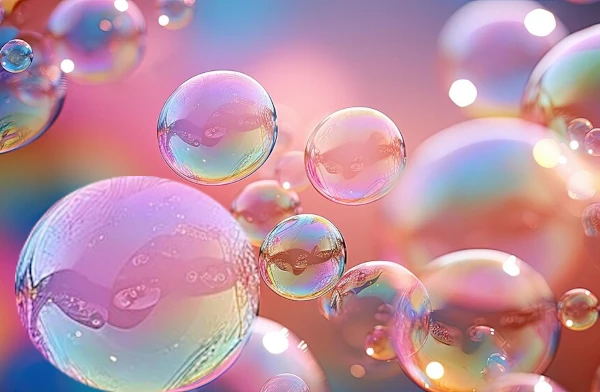
Image description: Life likely started in a bubble. Soap bubbles and cell membranes share similar physical principles influenced by electrostatic forces. They are formed by molecules that have a hydrophilic head (which interacts with water) and a hydrophobic tail (which avoids water). Image source astronoo.com
Long before ensuring replication, variation, and then selection, life needed a protective bubble, a minimum container, robust and easy to create, which could appear spontaneously in the environment of the time. This happened long before the emergence of the cell, the extremely complex building block of life that would appear much later, between 3.5 to 4 billion years ago.
The first simple organic bubbles likely formed relatively early in Earth's history, during a period called the Hadean (between 4.6 and 4 billion years ago).
The emergence of proto-cell membranes results from both electrostatic processes and natural selection, where only the most stable and functional structures persisted over time. These two mechanisms interact naturally (self-assembly) to promote the emergence and stability of the first structures. The formation of the first molecular assemblies and the construction of biological structures like proto-cell membranes took an enormous amount of time due to the random nature of the mechanisms involved.
The primitive environments of Earth, about 4.6 billion years ago, were characterized by a reducing atmosphere, intense volcanic activity, and the presence of hydrothermal vents. These environments provided a variety of elements and chemical compounds that could lead to the formation of simple structures based on carbon, hydrogen, and oxygen (CHO).
The white smoker theory is one of many hypotheses about the origin of life. It is plausible that life emerged in the depths of the oceans, under conditions still present today. Life could have emerged in underwater hydrothermal vents, where hot, mineral-rich water reacts with metal-rich rocks. These aqueous environments may have selected for chemical reactions favorable to the formation of complex organic molecules.

Image description: Primitive fatty acids consist of a carboxyl head (in red) that is polar, hydrophilic, and can interact with water via hydrogen bonds, and a linear hydrocarbon chain (in white) made up of carbon and hydrogen atoms, non-polar and hydrophobic. Carbon monoxide and dihydrogen, dissolved in water at high temperature, can naturally produce these chain-shaped molecules known as fatty acids on mineral surfaces.
The formation of the first containers represents a crucial step towards the emergence of life.
This production encompasses chemical, physical, and geological aspects that interact to result in structures capable of withstanding environmental turbulence for varying durations, depending on the temperature, size, and shape of lipid molecules.
One of the most accepted hypotheses for the formation of proto-cell containers is based on lipid chemistry. Fatty acids are good candidates for forming bubbles from simple carbon sources like carbon monoxide and dihydrogen near hydrothermal vents.
Fatty acids have the unique property of self-assembling into organized structures when placed in an aqueous environment, due to their amphiphilic nature (having a hydrophilic head and a hydrophobic tail). This self-assembly process is at the core of the formation of primitive membranes and structures such as micelles or vesicles, capable of capturing other molecules and forming closed compartments.
This dual nature makes fatty acids particularly adept at organizing in aqueous environments, as their different parts interact differently with water.
In an aqueous solution, at low concentration, fatty acids can form, through electromagnetic forces between atoms, balls called micelles, where the hydrophobic tails group together at the center of the spherical structure, while the hydrophilic heads are oriented outward in contact with water.
At higher concentrations, fatty acids can form lipid bilayers, where the hydrophobic tails face each other and the hydrophilic heads are in contact with water on both sides. These flexible bilayers, stirred by the random fluctuations of the water in which they are immersed, eventually initiate closure around themselves. They then form relatively stable, dynamic spherical vesicles (protocells) with an aqueous interior, creating a closed compartment.
The self-assembly and encapsulation process is amplified by the environmental conditions of hydrothermal vents. In this turbulent environment where temperature and hydrogen potential (pH) fluctuate, the concentration of fatty acids in the water promotes the formation of larger and more stable vesicles.
These encapsulated vesicles can undergo a series of events leading to self-replication. They can capture and retain other molecules present in their environment, enabling the first complex chemical reactions that are critical to the emergence of life.
The emergence of life on Earth represents a series of interactions between physics, chemistry, and biology. The first steps towards life were undoubtedly influenced by abiogenesis processes, with the formation of simple organic structures in aqueous environments.
Understanding these processes allows us to approach the question of life’s origins on Earth, shedding light on how life might arise elsewhere in the universe, a fundamental question in astrobiology.